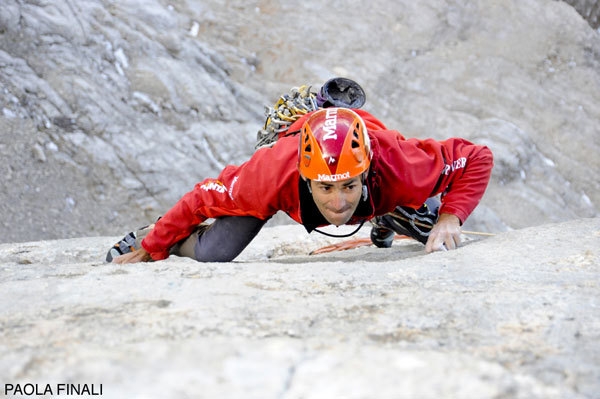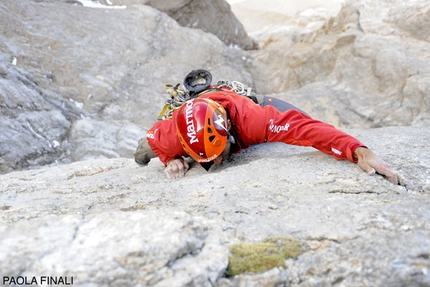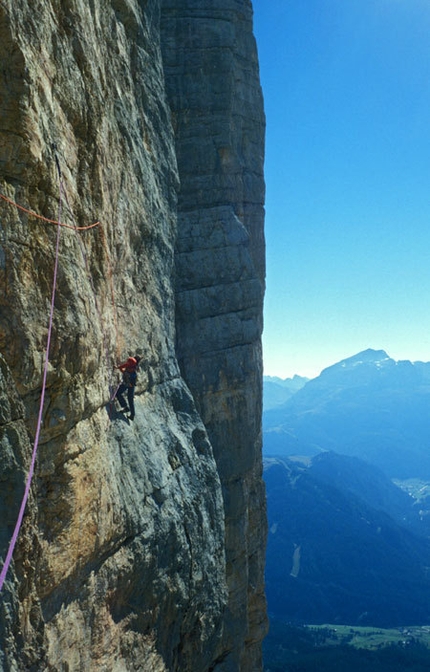The Messner slab on the Sass dla Crusc, Dolomites

 1 / 7
1 / 7 Paola Finali
Paola Finali
In our era which is consumed even before it is experienced, everything seems to dissolve without leaving a trace. Without even leaving a memory of the past. This holds true for alpinism, too, and only rarely do old stories rise to the surface. Or rather, fragments of old legends "rescued" from oblivion. One of these talks about the famous "Messner slab" on the via Pilastro di Mezzo on Sass dla Crusc, or Heiligkreuzkofel. That "impossible" section which, after 42 years, is still hotly discussed, and not just on internet forums. It is for this reason that Nicola Tondini - one of the premier activists in the Dolomites and as a prelude to his first ascent of Menhir on Sass dla Crusc - decided to investigate, film and examine those 4 smooth, vertical meters. Using this as a pretext, we also asked Heinz Mariacher to talk about those very same 4 meters. Mariacher certainly knows a thing a two about this reute seeing that not only did he leave a lasting impression on the evolution of climbing in the Dolomites, he also happened to carry out the first repeat and first free ascent of the Via Messner on Sass dla Crusc.
Before leaving you to Mariacher's thoughts and Tondini's analysis, we'd like to recount the other half of the story. The one which was written after the first ascent at the hands of the great Günther and Reinhold Messner. This is necessary not only because it gives an indication as to the importance of what Messner achieved, but above all because it helps to understand the scene in which this story is set and the evolution that followed. First of all therefore one must realise that that route did not immediately receive the recognition and fame it deserved. In 1968, the year of its first ascent, Sass dla Crusc certainly wasn't in the same limelight as say the South Face of the Marmolada, the NW Face of Civetta or the North Face of Sasslungo. Which meant that those incredible 4 meters climbed free by Reinhold Messner (grade VIII even today) went by relatively unnoticed. And the route as a whole, it's greatness and truly exceptional beauty, were somewhat misjudged and underestimated. Time needed to pass before people began to understand. And just like in many other cases, the route's success was decreed by... the failures of others. Of all the best who attempted, but failed. Yes, because there was no way about it: the years passed and no one managed to repeat it. Over time the route took on a mystery status, whispered about more often than shouted about, seeing that - as everyone knows - it's hard to talk about one's failures. But then, 10 years later, something finally really did happen. And as usual this didn't come about by chance. The time was simply ripe: an era had arrived in which a restricted group of young and semi-unknown alpinists had begun to explore a new road, which passed not only via climbing free, but which used a minimal amount of protection. One could argue that these alpinists attempted to improve upon, tried to continue in an original manner a theme which had been taken up by those preceding them...
So this is how on 16 July 1978 Heinz Mariacher reached the base of the "impossible" route. 24 years old and still relatively unknown, Mariacher was one of those explorers of a "new style" of climbing. He was joined by the extremely strong 19-year old Luisa Iovane (his life companion) and the unpredictable Luggi Rieser (now Swami Prem Darshano). It is worth mentioning that the Messner route was brought to Mariacher's attention by Almo Giambisi. At the time the hut warden of Rifugio Pordoi housed many of those young and "strange" alpinists and one could even go as far to say that the Pordoi hut welcomed this community with open arms. The three started up the route, unfazed by all the slings left behind by all those preceding them. After the pitch and abseil, they reached the famous "impossible" 4 meters. Right beneath this "wall" Heinz - who had read Messner's description carefully - lost his bearings. He was unclear above all about the section where Messner had described himself as being in a situation where he could no longer descend. And so, convinced that he was repeating the original line, he opted for what seemed to be the most logical solution, the one of "least resistance". Which resulted in a rightwards 12m traverse, followed by 4 meters of face climbing followed by a traverse back to reach the crack located above the 4m high Messner slab. From here the three climbers reached the summit, utterly certain they had carried out the first repeat of the mystery route. Only later, when talking to Reinhold Messner, did Mariacher understand that he had established a variant, the one which is named after him and which is most frequently used by climbers even today. But the story does not end here, for a year later Mariacher returned to Sass dla Crusc with Luisa Iovane and repeated the route free. This was the first integral free ascent seeing that Mariacher downclimbed the section which is usually lowered off and which leads to the crux slab, with difficulties up to VIII-. And then, on that famous section, he climbed 2 meters to the left of what is now considered to be the original line,. With difficulties up to VIII-, this was the route's first redpoint! And interesting detail: while Mariacher and Iovane were engaged in their repeat, the extremely talented Tyroleans Reinhard Schiestl and Luggi Rieser freed their Mefisto (VIII-)... a sign, if confirmation was needed, that the time was truly ripe!
All of this to underline that Messner's "impossible slab" is a part of a great story. A part of the exceptional Reinhold Messner and a part of the entire history of alpinism. Because to comprehend, to get an idea of the greater picture, one must not concentrate simply on single moves and their grades. And understanding does not come about by having the mathematical certainty that Messner climbed those precise holds. For one must not forget that there are plenty of other famous and "impossible" holds. Such as that incredible one, graded VIII- once again, which strangely enough no one talks about, carried out by Raffaele Carlesso on Torre Trieste in 1934. Carlesso always stated he had climbed it free and barefoot... (for the record, the first free repeat was carried out by Manolo, unsurprisingly in 1979). Or then there's the grade VII climbed alone by Domenico Bellenzier in 1964 up the Torre Alleghe on Monte Civetta. The list is endless... But in continuing we'd never discover what lies behind all of this: the ideas and that need for new visions, for the unknown, for exceeding oneself. Which are the damnation, the motor and very beauty of alpinism and alpinists.
Vinicio Stefanello
PILASTRO DI MEZZO DEL SASS DLA CRUSC BY HEINZ MARIACHER
In alpine literature the Pilastro di Messo is often reduced to only those famous, often cited, four meters. Almost no one has ever spared a thought for the rest of the route. For me the Pilastro di Mezzo is a fantastic line taken as a whole, which also ascends the four meter slab. Even today one could be proud of a new route of this sort.
The theme "Pilastro di Mezzo" is, once again, an excellent occasion to remember that the use of bolts hasn't always been such an obvious affair. I believe that only a handful of young climbers have read Reinhold Messner's polemic writings about the "Murder of the impossible", against the use of bolts. This is the case because a link is missing to the history of climbing, because youngsters are much more easily taken in by new role models and trends. A climbing culture which, at a certain point, became stuck in the snow of the 8000ers and which has woed itself into caring for it's monuments.
In Messner's era, and even in our days at the end of the '70's, there was still a code of honour. The limits which we chose to impose upon ourselves were the order of the day, they gave a sense to our game, for it was nice to dream about a line which was possible perhaps, or which perhaps wasn't. For me the Pilastro di Mezzo symbolised an apex for climbing in the Alps, something which developed in the Alps and which hadn't been imported from England or from America. The idea of doing without bolts on alpine rock faces deserved to continue - not necessarily as the only absolute truth - but as a particular style of climbing. I for my part, and for myself, chose to consider certain rock faces as "free zones", devoid of bolts. These included Sasso della Croce and the South Face of the Marmolada.
But let's return to the "Messner slab". Over the course of the years I've climbed that four meter section from four different angles. I believe however that the section is less important than the position the first ascentionist found himself in beneath the crux, is less important than the mental challenge so aptly described by Messner in his book "Ritorno ai monti". I think that nowadays only a small minority of climbers is capable of putting itself in that position and it's shameful that nowadays there are bolts on the Pilastro di Mezzo!
I'd like to make one other thing clear: during the first repeat I searched for the most logical line of ascent. This means the line of least resistance and I did not therefore search for a variant to get past the section as Rabanser described in his book. The fact that, shortly after the repeat, I asked Reinhold why in his original description he had omitted the traverse, proves I was convinced I'd repeated the original line.
Heinz Mariacher
ANALYSIS ON SASS DLA CRUSC – PILASTRO DI MEZZO by Nicola Tondini
For many years now the Pilastro di Mezzo on Sass dla Crusc has been intrinsically linked to the Messner brothers. Reinhold and Günther Messner climbed the smooth slabs of the 200m high pillar wedged into the massive Sass dla Crusc on 6 and 7 July 1968. Those who have repeated Reinhold's Dolomite routes know full-well how this strong climber was attracted to slabs. Despite having only pegs and wearing rigid boots, Messner often set out to search for a sequence of holds which would enable him to climb those compact grey limestone walls: the North Face of the second Sella Tower, the North Face of Sass da Putia, the North Face o Cima del Velo della Madonna, the South Face of the Marmolada, the friction slabs on Sasso delle Nove and Sass dla Crusc were some of his playgrounds and testament to his immense intuition. Even today these routes arouse fear: long run-outs and the need to read the slabs correctly are the reason why many climbers heed the routes of this South Tyrolean alpinist.
On Via Pilastro di Mezzo on Sass dla Crusc, Reinhold Messner created a true masterpiece with his brother Günther. Right from the outset the two brothers worked hard to find a line upwards and they were forced into a long traverse with a pendulum to get past an extremely smooth section. And then, on the 4th pitch, they came across that 4m slab just above a small ledge. They could sense the holds, but these were decidedly small. Messner stayed there for almost an hour, attempting to understand how to get past. He then risked it all, and succeeded. In doing so he climbed the first grade VIII in history, free.
Over time this section has gained notoriety. Some claim on internet forums to have found easier ways up than the Mariacher variation. But the fact of the matter is that the original section continues to prove a sticking point for many. I myself had read and heard various thoughts about those moves: did he perhaps place a peg, had perhaps a hold broken off in the meantime, how could it be that he succeeded while so many other strong climbers backed off? And so on. I repeated the route for the first time 18 years ago and at the time I climbed the route intent on doing the Mariacher variation. Obviously I was curious to try the Messner slab and so I recently suggested to Massimo Lucco, an extremely strong friend and client, that we give it a shot to understand it better. We decided to climb the route on 3 September, and a couple of days beforehand I got in touch with Andrea Tosi and Paola Finali, two expert photographers and filmmakers who have been following me lately on some of my adventures. I suggested they film the famous Messner slab.
On 3 September Massimo and I reached the base of Diedro Mayerl and climbed this to the ledge at half-height. From here we traversed left along the ledge and in 10 minutes reached the start of the Messner route on the Pilastro di Mezzo (in truth the original line reaches the ledge direct by climbing 300m up an extremely loose and dangerous grade V pillar). It was just gone 10am. I phoned Andrea who had reached the top on foot together with Paolo, Ingo and Mario. While Massimo and I climbed the first pitches, they fixed the static ropes for the shoot, so when I reached the 4th pitch Andrea and Paola were already in loco. In order to attempt the Messner slab I belayed as indicated in the precise description by Ivo Rabanser. Before trying the moves from below I looked at the section on top rope. It took me a while to understand how to do the sequence without making it extremely difficult. In the end I set off from below and did it, a difficult single crux grade VIII (7a). There are three crimps which are hard to hold. But how come it's so difficult to on-sight therefore? The answer is simple:
- just like many "bizarre" boulder problems, this too has a start which is difficult to get right. You naturally want to set off with one foot, but it you do so you get stuck right away. If on the other-hand you start with the "wrong" foot you then find that the sequence flows correctly and the section can be climbed if you have good finger strength. Something which Messner certainly wasn't lacking.
- psychologically you're not in a great position:
a) your partner cannot see you or, if you decide to belay immediately beneath this section, you risk falling directly onto the belay;
b) if you fall you can easily hit the ledge, unless you throw yourself vigourously out into the void
c) the gear isn't run-out, but nevertheless it's beneath your feet
d) you realise that if you make a mistake, there's no turning back
e) there's an easier exit: the Mariacher variant
I'd like to conclude by saying that Messner, in climbing those 4 meters, created a masterpiece. I believe he free climbed it and that no fundamental holds have broken since his first ascent. He studied the moves for an hour and then, with the determination which has always set him apart, he set off with the correct foot sequence, pulled with all his might on those 2-3 crux crimps and reached the good holds which led to easier ground.
Nicola Tondini
VIDEO filmed and edited by Andrea Tosi of Nicola Tondini's ascent of the "Messner slab" after having attempted it on toprope.
| Links Planetmountain | |
| News Nicola Tondini | |
| Links www | |
| www.paolafinali.com | |
| www.xmountain.it | |
| Expo.Planetmountain | |
| Expo Ferrino | |



 Copia link
Copia link







 See all photos
See all photos





















